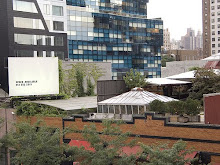

 1) View of Confucius Plaza from Bayard Street, 2009. 2) Statue of Confucius by Liu Shih with bilingual inscription of “The Chapter of Great Harmony (Ta Tung)” by Confucius, 2009.3) View of Confucius Plaza courtyard, facing Division Street, 2009.
1) View of Confucius Plaza from Bayard Street, 2009. 2) Statue of Confucius by Liu Shih with bilingual inscription of “The Chapter of Great Harmony (Ta Tung)” by Confucius, 2009.3) View of Confucius Plaza courtyard, facing Division Street, 2009.
33 Bowery (at Bayard Street), New York, NY 10002
N/Q/R/W/6/J/M/Z to Canal Street, B/D to Grand Street
At 44 stories tall, Confucius Plaza is the largest building in Chinatown. As a project developed for and by Chinese Americans and Chinese immigrants, Confucius Plaza is a milestone in the legitimization of Asian American minorities, and especially as an example of "circumstances under which a particular immigrant population ... [has] overcome the obstacles posed by financial exclusion."[1] However, in order to fully understand the political and cultural significance of the Plaza, it is first necessary to briefly discuss the history and racialization of Chinese in America and of Chinatowns in America, specifically New York's Chinatown.
In his book New York before Chinatown, Professor John Kuo Wei Tchen of NYU writes: "The use of Chinese things, ideas, and people in the United States, in various imagined and real forms, has been instrumental in forming this nation's cultural identity."[2] As an important port city and commercial center, New York especially "[played] a pivotal role in promoting representations of China and the Chinese that would be highly consequential to the destiny of Chinese New Yorkers."[3] By the early 19th century, Lower Manhattan, centered around the Bowery, became a multicultural neighborhood in which Chinese and Irish immigrants, as well as freed black migrants and others, communed. However, as cheap laborers, the Chinese posed a threat (whether imagined or real) to non-Chinese workers; animosity towards Chinese rose, producing images of the Chinese as malicious criminals and opium addicts, and as dirty and unsanitary, conflating race with disease and contamination.[4]
In 1882, the Chinese Exclusion Act was passed, which, along with the later Immigrant Act of 1924, essentially prohibited Chinese immigration into the United States until the Immigrant Act of 1965, which once again allowed large numbers of Chinese and other immigrants who had previously been restricted to enter the country. In particular, the influx of Chinese women, who had always been restricted under racist and sexist assumptions that they were prostitutes, along with the reunion of transnational families, a priority under the new law, transformed what was once considered a bachelor society of Chinese American men into a new population of Chinese immigrant/Chinese American families. As the New York Chinese immigrant population grew, it clustered around Mott, Pell, and Doyers Streets.[5]
In 1974, Confucius Plaza began construction. Initiated by a Chinese American store owner named Kumshui Stephen Law, who organized a development group through word of mouth and the use of Chinese-language newspapers,[6] and funded mainly by the Mitchell-Lama Housing Program, the project became the center of a significant protest led by Asian Americans for Equal Employment, who "decried the lack of Chinese or Asian American construction workers." Later joined by a host of other Chinatown organizations, as well as citywide minority workers' groups including the Black and Puerto Rican Coalition, the AAFEE's demonstrations led to the hiring of roughly 40 Asian American workers as well as the addition of a multitude of community and commercial facilities to the complex.[7] Today, Confucius Plaza remains a physically imposing structure in the heart of Chinatown, and also as a cultural center for Chinese Americans, providing amenities for its residents like day-care services and elderly care. Buses run between Confucius Plaza and the neighborhood of Flushing, Queens, what Jan Lin calls a "satellite Chinatown,"[8] uniting spatially separate Asian American communities across New York's boroughs. A statue of Confucius, created by Liu Shih and gifted by the Chinese Consolidated Benevolence Association, stands as a reminder of the political empowerment of the Chinese American community.
- Adela Park and Eric Zhang
Works Cited:
Li, Wei et al. “Chinese-American Banking and Community Development in Los Angeles County.” Annals of the Association of American Geographers. 92.4 (2002): 777-96.
Lin, Jan. Reconstructing Chinatown: Ethnic Enclave, Global Change. Minneapolis: University of Minnesota Press, 1998.
Nash, Phil Tajitsu. “Kumshui, Tsiwen and Confucius Plaza.” Asianweek. 4.7 (Oct 5-Oct 11, 2007).
Shah, Nayan. “Regulating Bodies and Space.” Contagious Divides: Epidemics and Race in San Francisco’s Chinatown. Berkeley: University of California Press, 2001. 45-76.
Tchen, John Kuo Wei. New York before Chinatown: Orientalism and the Shaping of American Culture 1776-1882. Baltimore: Johns Hopkins University Press, 1999.
[1] Li et al., 778.
[2] Tchen, xv.
[3] Ibid, 63.
[4] See Tchen and Shah.
[5] Lin, 31.
[6] Nash.
[7] Lin, 134-5.
[8] Ibid, 110.

No comments:
Post a Comment